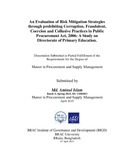| dc.description.abstract | The risks in the public procurement simply means the events that make the
procurement process jeopardized and or the benefits of the public procurement are not
achieved adhering to true to the processes of activities as stated in the Government’s
Procurement Legal Framework/ Policy. In Bangladesh country perspective the public
procurement risks originated from the activities not properly maintained by the
Procurement Entities (PE) as stated in the PPA, 2006, the Government’s Procurement
Legal Framework for public procurement.
Some potential risks may occur in the public procurement activities either from the
activities of corruption or Fraudulent or Collusive and Coercion (CFCC) practices by
the involved parties and or socioeconomic or sociopolitical conditions.
There are many risks involved in every steps of the public procurement process as the
whole nation has stake with it. The PPA, 2006 has included many of the tools as the
strategic risk mitigation tools to mitigate the risks may arise in the implementation
stages of the public procurement process by the PE’s operational activities. DPE’s
operational activities of the procurement processes were evaluated in comparison to
the strategic risk mitigation tools mentioned in the PPA, 2006 in the current study.
A number of unwanted incidents which make paralyzed the public procurement
process of DPE were evaluated in this research. Based on the PPA, 2006 and PPR,
2008 provisions which mitigate risks in the public procurement process were
evaluated and recommended some activities which were the essence of the risk free
procurement process for DPE, Development Partners and the government.
DPE, being one of the largest government organizations in Bangladesh, has to procure
different types of goods and services from national and international markets both
from the suppliers and consulting firms. DPE has to follow the Public Procurement
Act, 2006 and the Public Procurement Rules, 2008 for procurements using GoB fund.
DPE also follow PPA, 2006 and PPR, 2008 for the different stages of procurement
process which are not mentioned in the Development Partners (DPs) Procurement
Guidelines. But after conducting this study it was found that there is room for DPE to
improve the procurement process compliance with all of the procurement Guidelines
which were recommended from this study.
Possessing the necessary logistics for transforming the procurement processes from
the current manual systems to the worldwide accepted electronic system, DPE should adopt e-GP for all its procurement processes. By transforming from the manual
systems to the e-GP, DPE can ensure more transparency and efficiency in procurement
process with the risks from Corruption, Fraudulent, Coercion and Collusive practices
at a minimum level. DPE was strongly recommended from the current study to adopt
e-GP with some other recommendations for operational compliance with the strategic
risk mitigation tools mentioned in the PPA, 2006. | en_US |

